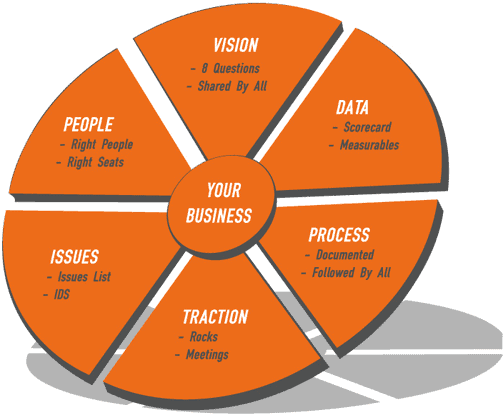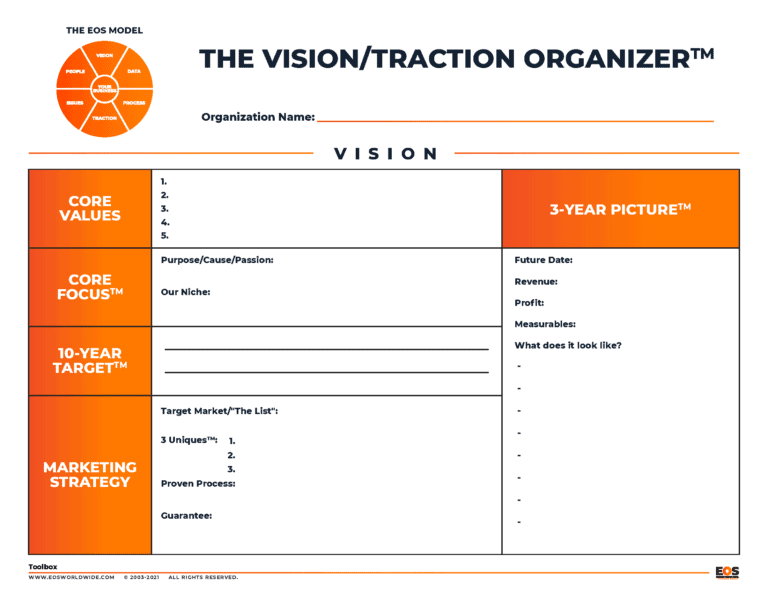Do you know how to align your EOS® marketing strategy with the vision (V/TO®) of your business?
Whether you’ve proudly run on EOS® for years or are brand new to the Entrepreneurial Operating System, it’s important to make sure all your marketing efforts further your business goals. Otherwise, you’ll waste a lot of time and money building websites, posting on social media, etc., etc. without actually growing your business.
This guide will help you understand the marketing strategy component of EOS, reconcile it with your 10-Year TargetTM, and build campaigns that accomplish your goals.

Understanding the EOS® Framework
Popularized by Gino Wickman in books like Traction, EOS® stands for Entrepreneurial Operating System. This model of running a company uses a simple set of tools and principles to organize and optimize the energy you spend on your business.
EOS® is also called a “people operating system” because it works to maximize the value of your most important asset—your people. With EOS®, everyone on your team works towards the same goals in the most productive and enriching way possible.
The Three Goals of EOS®
While EOS® is a complete and diverse management toolkit, every part of the system helps you and your leadership team get better at three things they call:
- Vision
- Traction®
- Healthy
Vision is setting a direction for your organization—revealing where you want to go and how you plan to get there.
Traction refers to the day-to-day execution of the vision—the focus, discipline, and accountability it takes to keep your company running smoothly and profitably.
Healthy ensures your leaders are a cohesive, functional, and healthy team.

The Role of Vision in EOS®-Run Companies
No component of EOS is more important than vision. Everything you do flows through the vision. You start with it, plan work around it, and measure goals to it.
Without a clear vision, a company cannot move forward—simply because it doesn’t know where it’s trying to go! Too many organizations think they have a clear vision only to discover that in reality, their team members all have different ideas about where they’re headed.
EOS® helps businesses simplify and spread their vision so that it becomes a North Star, guiding their initiatives into a bright future.
The Vision Traction Organizer (V/TO®)
Built on practicality, EOS® offers a tool for vision it calls the Vision Traction Organizer or V/TO®.
The V/TO® is a short document that streamlines your organization’s vision planning process and documents the results in a single-page format. Unlike many of the extensive strategic plans that many companies create, the V/TO® is short enough for everyone to read and simple enough for everyone to follow. As the name suggests, it has two main parts: Vision and Traction.
Vision
The Vision page of the V/TO® has five sections:
- Core Values: Characteristics that represent your company and culture
- Core Focus ™: Why your company exists and what is your superior skill
- 10-Year Target™: A picture of the future that everyone can grab hold of
- Marketing Strategy: How you sell your product or service
- Target Market
- 3 Uniques™
- Proven Process
- Guarantee
- 3-Year Picture™: A clear image of your company three years from now
Traction
The Traction page of the V/TO has five sections:
- 1-Year Plan: One third of your 3-year picture— specific targets and goals that will enable you to meet them
- Rocks: 3-7 priorities for the next 90 days
- Issues List: A list of all the obstacles, challenges, and opportunities your team needs to discuss
As you can see, the V/TO® is a straightforward tool that makes it easy to summarize the key parts of your organization’s vision. If properly completed, the V/TO® can cast a vision for who you are and where you hope to be that will optimize your business long into the future.
However, as you might guess, getting all of these components to work together is a significant challenge in itself. This is especially true when it comes to your EOS marketing strategy. How do you use a V/TO® to strategize and execute campaigns that align with your vision?
We turn to that question next.

Aligning EOS Marketing Strategy with Vision
Let’s lay out a simple and repeatable process for getting your EOS marketing strategy to align with your vision.
- Use your Core Values and Core Focus™ to inform your brand messaging.
Brand messaging is the story your company tells. It is what you say and how you communicate. To align your marketing with your vision you need to start here—not with specific campaigns and platforms, but with the core of who you are and the narrative you present. The best companies create a brand voice and message that closely mirrors their values.
If you’ve identified values that resonate throughout your organization, you need to present these in your marketing. Not necessarily by copying and pasting to your About Page, though sometimes that can be helpful. Instead, they should color the language you use, the tone with which you communicate, and even the design elements you include.
An easy way to do this is to imagine your brand is a person.
- How would a person with those core values speak?
- How would they look?
- What kind of feeling would others get from interacting with them?
This identity should be such a part of your messaging that if a customer were to stumble across your core values after interacting with you, they wouldn’t be surprised in the least. And no matter what channel you end up using for marketing, this message should be consistent. If every platform you use communicates the same identity and values, every time a prospect interacts with your brand, they’ll have an accurate understanding of who you are and what you do.
- Get highly specific about your target market (“The List”)
Some companies would gladly take any business they can get, but EOS®-run companies know they need to focus on a target market.
This is the center of the bullseye—the ideal audience that you want to reach. To come up with a strong marketing strategy, you need to know exactly who you are marketing to:
- What are their demographics? (age, gender, income, education, etc)
- What are their psychographics? (values, goals, interests, and lifestyle choices)
The more you narrow down this target, the better. Here’s a litmus test: is the criteria clear enough you could make a “dream list” of prospects to target in your marketing? For B2B companies, think of who you would ask your sales team to begin conversations with. Where would you send them geographically? What industries? Company size?
Get as specific as you can about your target market and you’ll be able to focus your marketing efforts more directly and more effectively in the next steps.
- Determine what business priorities marketing can support
Now it’s time to decide where marketing can help. There are some priorities that marketing can support and others that it has little impact on.
These are likely fairly obvious. If your 3-year picture™ or 1-year plan contains sales, recruitment, or brand goals, marketing will be a great help. If your goals are more focused on internal processes and profitability, marketing might play a smaller role. (Though clear messaging and identification of a target market will benefit each of these.)
Take a long look at your business goals and mark the ones marketing can support. (Ask yourself “if our marketing worked perfectly, would this goal be easier to achieve?” If yes, there is a role for marketing in your plans.)
- Determine what marketing goals lead to your business goals
Marketing goals and business goals have overlap but they are not the same thing. While a business goal might be to increase revenue, hire a certain number of employees, or launch a new product, marketing goals include things like:
- Building brand awareness
- Increasing brand engagement
- Generating leads
- Boosting lead conversion
Ask your team which marketing goals would advance your business goals.
- If more people were aware of your brand would it be easier to recruit new employees?
- If you converted more leads would you be able to cut down expenses?
- If more leads flowed through your pipeline would your revenue targets seem more manageable?
It’s very important to work through this step before you jump into platforms and specific strategies. While any business might want more website traffic or social media followers, these numbers are arbitrary unless they contribute to your business objectives. Working back slowly from your business goals ensures that you aren’t spending time and money on marketing that doesn’t move the right needle.
- Choose your marketing strategies and platforms carefully
You should now have a business goal and marketing goal that aligns with your vision. (Ie “We want to hit $1 million in revenue in three years. To do that, we need to increase awareness of our brand.”)
With these goals in mind, now it’s finally time to look at marketing strategies and platforms. Which efforts would help you reach your target?
While not exhaustive, here is a list of some marketing goals and the strategies that support them:
- Increase brand awareness: Content marketing, search engine optimization, social media campaigns, in-person and virtual events, paid advertising
- Better qualified leads: Content marketing, nurture campaigns, published case studies
- Increase customer engagement: Social media content, optimize website user experience, personalized email communication, conducting feedback sessions
- Enhance customer retention: Post-purchase emails, customer feedback, customer loyalty programs, client relationship management system
- Expand market reach: Location-specific campaigns, social media targeting, paid advertising
This list could go on and on, but by considering it you’re already ahead of most businesses. You’re only looking at efforts that are directly tied to your goals and thus to your vision. We recommend you select the top couple of marketing goals for your business and about three marketing strategies to support each one.
- Turn KPIs into SMART rocks and scorecard metrics
Every marketing strategy you select will have key performance indicators or KPIs. These are the actual metrics that tell you how your efforts are performing. (Ie number of new website visitors tells you how many people are becoming aware of and interested in your brand. With proper attribution, you’ll know those ads you’ve been paying for are really working.)
Once you know what these KPIs are, you can turn them into scorecard metrics and SMART rocks.
- Report out on the performance of a strategy with a scorecard metric at your weekly L10 meeting
- Develop SMART rocks that further these goals (“by the end of Q2, I will create a landing page that increases lead conversions”)
By integrating these metrics into the EOS tools, you’ll keep them visible. It will also ensure that your team is only talking about marketing efforts that further your goals and thus vision—instead of getting bogged down in the millions of data points available.
- Adjust and optimize your EOS marketing strategy over time
If you’ve followed the process we’ve outlined above, you will have:
- Identified marketing goals that align with your 10-Year TargetTM, 3-Year PictureTM, and 1 Year Plan
- Determined strategies that advance those marketing goals
- Tracked metrics that chart your marketing performance
With all of these in hand, you’ll be able to see how your marketing strategies further your company’s vision. You can adjust strategies and metrics as needed to keep moving forward and advancing toward your 10-Year TargetTM—all the while remaining true to the vision of your organization.

From Vision to Reality: Crafting an EOS-Aligned Marketing Strategy
The key to successful marketing in an EOS-run company is not just about choosing the right platforms or tactics, but about ensuring that every aspect of your marketing aligns with and supports your overall business vision. This means regularly revisiting your marketing strategy, measuring its effectiveness against your business goals, and making necessary adjustments. By integrating EOS tools like the V/TO®, SMART Rocks, and scorecard metrics into your marketing planning and execution, you keep your team focused and aligned with your vision.
Ultimately, when your marketing strategy is in harmony with your company’s vision, you not only achieve your business objectives more efficiently but also create a strong, enduring brand that resonates with your customers and stands out in the marketplace. This alignment is the cornerstone of long-term success, ensuring that your company continues to grow and thrive, guided by a clear, compelling vision that informs every decision you make.



